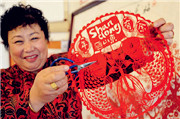Hisense to expand overseas markets
( chinadaily.com.cn )
Updated: 2017-06-21
|
|||||||||
Chinese appliance maker Hisense is planning to expand its overseas markets by selling more high-end and large-screen televisions overseas.
Hisense announced that the N8700 series, the new overseas models of ULED, are officially sold in more than 30 countries and regions around the world and that the company will expand its global markets through ULED technology.
Zhu Dan, deputy general manager of Hisense International Marketing Company, said that the sales pace of high-end products overseas has been accelerated by Hesense‘s world-class technology.
Hisense sees internationalization as its key expansion strategy. It has established seven research and development centers in the United States, Japan and Germany, and overseas manufacturing bases in South Africa, Mexico and the Czech Republic.
Hisense's global production layout has also taken shape. It purchased Sharp's TV manufacturing factory in Mexico two years ago, finished expansion and transformation of factories in South Africa, and constructed a manufacturing base in Algeria.
By virtue of supporting international sports events, Hisense has plunged into the overseas market. It has sponsored F1 Red Bull Racing, the Australian Open tennis final and made a contract with FIFA in April this year to become the official sponsor of the 2018 FIFA World Cup.
Liu Hongxin, president of Hisense Group, recently announced the plan to promote its brand worldwide to increase global market share by supporting major sports events.
The ULED TV of the Hisense MU9600 series won an International Innovation Award at CES Asia 2017, which enhanced the international influence of China's ULED TV industry.
According to statistics from China Market Monitor Co, Ltd, a Chinese appliance researcher, the sales volume and profit of Hisense ULED recorded increases of 226.37 percent and 152.04 percent, and those of Hisense 55+ large flat-screen TVs increased by 18.59 percent in the first four months of this year. It continues to outperform Japanese and Korean brands.




